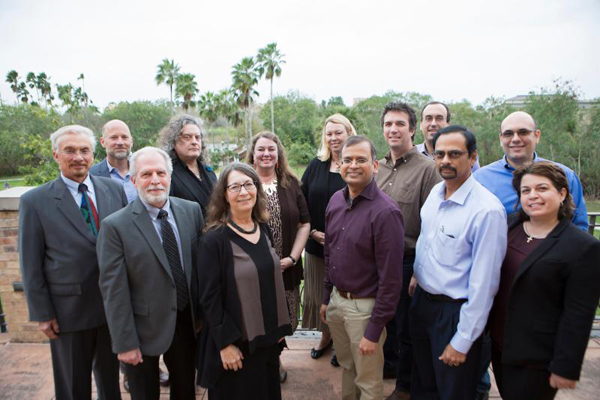Don't Miss
- La Feria Native Soon To Retire From The Military This Summer
- Senior Eneece Avila Takes Pride in her State Title
- Dr. Noemi Infante, Harlingen Medical Center Open New Women’s Clinic
- Santa Rosa Cameron County Park Partially Reopens
- Santa Rosa Takes to Regionals Meet in Kingsville, Tx
- Long-Standing Nexstar Tower in La Feria Decommissioned
- Lionettes Powerlifting Meet
- Local Business Holds Event to Benefit RGV Shriners Club
- Knights of Columbus Holds it’s 30th Annual Golf Tournament
- KGBT Tower Dismantled
Get Out and Go Running: UTRGV’s South Texas Diabetes and Obesity Institute Working to Bring Attention to Diabetes
- Updated: December 7, 2018

The UTRGV School of Medicine’s South Texas Diabetes and Obesity Institute team of researchers continues its world-class biomedical research on diabetes, obesity, heart disease, ocular health, psychiatric disease, osteoporosis, and infectious diseases like Chagas disease and tuberculosis. UTRGV Archive Photo by Veronica Gaona
by Amanda L. Alaniz
RIO GRANDE VALLEY, TEXAS – Diabetes is one of the most common and complex diseases in the United States, and according to the International Diabetes Federation, the number of people with diabetes is expected to rise to 522 million by 2030.
“We don’t have any cure at this point,” said Dr. Rector Arya, UTRGV assistant professor of research and part of the School of Medicine’s South Texas Diabetes and Obesity Institute (STDOI).
“We can control diabetes, which is a complex and progressive endocrine disorder caused by genetic and environmental factors and their interactions. We’re on the road to find the cure,” Arya said. “But at this point, prevention is better than a cure.”
The STDOI was established in 2014 and focuses on the health of the South Texas community through research on diabetes, obesity, heart disease and related disorders.
Given the prevalence of the disease, the month of November has been dedicated to bringing awareness to a rampant and growing problem: The Centers for Disease Control and Prevention report about 30.3 million people in the United States alone have diabetes, with 23.1 million diagnosed and 7.2 million going undiagnosed. And about 84.1 million people of U.S. adults have prediabetes.
There are two types of diabetes:
- Type 1 is a condition in which the pancreas produces little or no insulin, a hormone needed to allow sugar (or glucose) to enter cells to produce energy. A patient will need insulin therapy to manage.
- Type 2 diabetes (T2D) is a condition that affects the way a person’s body metabolizes sugar (glucose), the body’s source of fuel. The body either resists the effects of insulin – the hormone that regulates the movement of sugar into the cells – or the pancreas doesn’t produce enough to maintain a normal glucose level. Affected individuals generally need to make lifestyle changes, like diet and exercise, along with medications, to control it.
STDOI is working to address the most critical public health problems in the Rio Grande Valley, such as Type 2 diabetes (T2D) and other cardio metabolic risk factors.
“Mexican Americans, compared to other populations, are more prone to complex diseases such as obesity and T2D, and have an increased prevalence of T2D compared to non-Hispanic whites,” Arya said.
PREVALENCE
Arya has taken part in research focused on obesity, diabetes and metabolic syndrome in particular populations, such as Mexican Americans. In a preliminary study called the “Rio Grande Valley Epidemiologic Study,” conducted in the Valley, Arya and some colleagues collected information on cardiovascular risk factors, diabetes and obesity.
From the data gathered, they noticed Mexican American adults 18 and older had a high occurrence of obesity and diabetes. The prevalence of T2D in adults is about 29.6 percent: Of 585 subjects, 173 have T2D. On the other hand, prevalence of overweight and obese conditions in the Valley population are about 32 percent and 47.4 percent, respectively. The study has not been published yet.
- In general, the prevalence of T2D in the Rio Grande Valley is about 30 percent – about 20 percent higher than that of Texas as a whole or the general population.
“These factors go hand-in-hand in each and every population we see,” Arya said. “Overweight and insulin resistance start together. Once you are overweight, you’re also insulin resistant. You’re on the road to obesity soon if you don’t make any lifestyle changes.”
Arya said Type 2 diabetes isn’t a condition that happens overnight; it’s generally a progressive disorder that could be prevented if caught early and lifestyle changes are made.
“If you find yourself in that situation, where your glucose levels aren’t normal, that is the stage where if you make strict lifestyle changes, things can be corrected,” he said.
A CRITICAL PROBLEM
Dr. Christopher Jenkinson, UTRGV professor and STDOI faculty, said Type 2 is the major health scourge in society today, in particular in the Valley’s Hispanic community.
“Type 2 is essentially a lifestyle problem and it’s become increasingly worse over the last few decades as the population becomes more obese. As the population becomes more obese, they become more insulin resistant,” he said. “Obesity is the strongest risk factor for Type 2 diabetes.”
Jenkinson’s own research focuses on molecular genetics relating to diabetes, obesity, insulin resistance and related metabolic disorders. His current study, still in its preliminary stages, is looking into a protein found in fat cells that could be related to insulin resistance.
“People tend to think, ‘Oh, it’s a relatively benign condition. Everybody has diabetes Type 2 or prediabetes, and they’re all surviving.’ But in fact, it’s a severe metabolic disorder,” Jenkinson said.
There are numerous complications associated with uncontrolled diabetes, such as blindness and amputations. The key is to control glucose levels by making deliberate lifestyle changes, he said.
Arya and Jenkinson heavily endorse healthier eating choices. Watching your weight and adding exercise to your daily routines can help prevent and control the disease.
About 80 percent of T2D cases can be prevented by adopting healthy lifestyle changes.
“If you’re able to diminish the obesity level, then you’re going to have a much better prospect of dealing with Type 2 diabetes,” Jenkinson said.
You can learn more about the research being done by STDOI by visiting https://www.utrgv.edu/som/stdoi.






